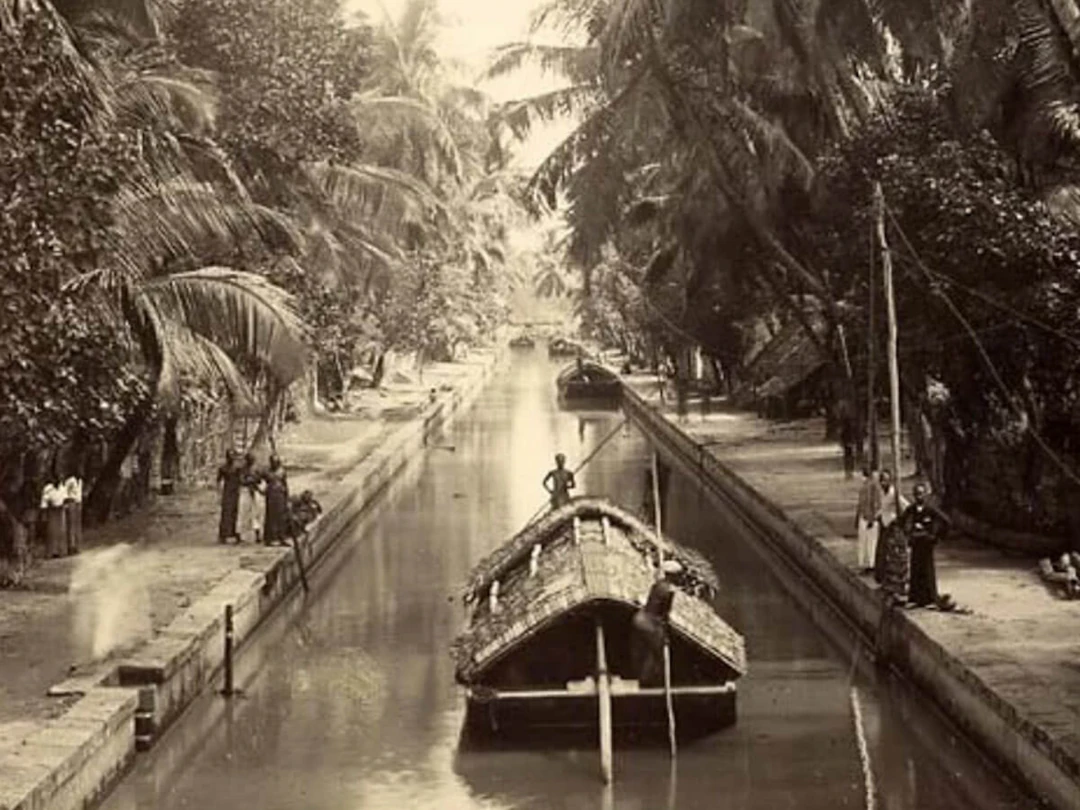
Photo by Tbachner
The Hamilton Canal Negombo, also commonly known as (among locals) Hæmiltan Æla, is a waterway Stretching over 14 kilometers(9.0 mi). This canal winds its way through Sri Lanka’s coastal towns, connecting Puttalam to Colombo and passing through the bustling city of Negombo. Today, this channel is known as the Dutch Canal Negombo.
Originally built by the British in 1802, the canal holds remnants of Dutch influence and centuries of history. This is a must-visit place in Sri Lanka, especially if you’re a first-time visitor. So, let me tell you a bit more about one of the most important channels in Sri Lanka. Let’s start with the history.
Ancient Origins and Early Development of the Hamilton Canal

The story of the Hamilton Canal starts long before the British or the Dutch ever set foot in Sri Lanka. The first mention of canals in this region goes way back to the 8th century when the Persian geographer Abu Zayd al-Balkhi wrote about a voyage through the “Gobbs of Serendib.” This was a term used to describe the interconnected lagoons along Sri Lanka’s western coastline.
The idea of connecting waterways for travel and trade had been around for ages, and it set the foundation for what would become a vital network of canals.
In the 15th century, King Veera Parakramabahu VIII of Kotte recognized how valuable these water routes could be and initiated the construction of a more organized canal system. His plan was simply to link up the surrounding villages with Colombo and the Negombo Lagoon to make transporting goods easier.
Back then, areca nuts, spices like cardamom and cloves, and, of course, cinnamon were the prized exports of the kingdom. These canals became crucial for getting these products to the main seaport in Negombo, boosting trade and the local economy. King Parakramabahu’s canal network was one of the earliest large-scale projects of its kind in Sri Lanka.
Dutch Influence and Expansion
By the time the Dutch arrived in Sri Lanka in the 17th century, they saw the potential in the existing canal system and took it even further. Between 1658 and 1795, the Dutch went all in on expanding the network, adding new canals and structures designed to solve two main problems. First, they wanted to protect their rice fields from the coastal tides that flooded them with salt water.
It was a constant battle between the sea and the land, and the Dutch engineers did their best to tip the balance in their favor. Second, they wanted a more efficient way to transport goods, especially cinnamon, which was as valuable as gold at the time.
The Dutch then engineered a extended network that eventually spanned 172 kilometers, connecting key ports and making transportation across the region smoother than ever.
The canals became the main arteries of trade for the Dutch-held ports, tying the entire region together. Whether it was small villages or bustling towns, these waterways helped transform the landscape of Sri Lanka during the Dutch era.
British Era and the Construction of the Hamilton Canal
When the British took control of Sri Lanka in 1796, they saw an opportunity to basically reshape Sri Lankan infrastructure. So they started with its waterways. The Dutch had already built an extensive canal system, but in 1802, British initiated the construction of what we now know as the Hamilton Canal.
The British aimed to use the canal to manage the saltwater flooding that had plagued the Muthurajawela wetlands for years, so the British thought they could drain the saltwater from the wetlands and create more arable land, which would benefit the island’s agriculture and economy.
The Hamilton Canal, stretching for 14.5 kilometers, was positioned closer to the sea than its Dutch predecessor, running parallel to it. This proximity to the coast made it particularly useful for transporting goods like cinnamon between Colombo and Negombo.
However, the construction also had unforeseen consequences. While the canal did help with transportation, it worsened the salinity in the wetlands, making the problem of saltwater intrusion even more extreme.
The Role of Gavin Hamilton and British Strategy
Gavin Hamilton, the British Government Agent of Revenue and Commerce, played a crucial role in planning the canal’s construction. He was closely involved in British strategies for developing the island’s infrastructure. In fact, Hamilton’s vision for the canal was driven mainly by his wish to bolster British control over the local economy. The canal would help with drainage and provide a quicker route for transporting goods like cinnamon, a hot commodity at the time.
Hamilton, while ambitious and influential, wasn’t exactly the most honest figure in British colonial history. Shortly after the canal project began, he was caught up in an embezzlement scandal.
By the time he died in 1803 before the canal was completed, it was discovered that Hamilton had siphoned off £19,675—an enormous sum at the time. Despite his financial misdeeds, the canal was finished in 1804, and they still use his name for it even after the legal issues.
Modern-Day Restoration and Tourism
Neglected for decades and struggling with the environmental impact of increasing salinity, the canal was no longer serving its original purpose.
In 2012, the Sri Lanka Land Reclamation and Development Corporation (SLLRDC) launched a major restoration effort to bring the canal back to its former glory, but this time with a focus on environmental preservation and tourism. The project was broken down into two phases and was generously funded by the Japanese Bank for International Cooperation, which provided the financial backing to breathe new life into the historic canal.
https://www.youtube.com/watch?v=FeAN5QEbdBM
The project’s first phase focused on restoring a 9-kilometer stretch between Maha Oya and Negombo, aiming to improve both the water quality and the surrounding infrastructure. The first phase focused on a 9 km section between Maha Oya and Negombo. The second phase, which commenced in early 2013, covered the area from Kelani Ganga to Negombo. By August 2013, a crucial 2.5 km stretch between Hekiththa junction and Pinwatta was completed, costing Rs. 400 million.
After that, the only major update that I found was in 2020, saying, “Steps to redevelop Hamilton Canal as a major tourist attraction.” After that, what happened was a bit unclear.
Today, the Hamilton Canal has found a new purpose. Instead of carrying barges filled with cinnamon or being used for complex drainage systems, it has become a scenic route that draws tourists, particularly in Negombo. One of the best ways to explore the canal these days is by bike. If you want more information, read the “5 must-visit places when planning your cycling trip around Negombo” article.
Many local hotels rent out bicycles to tourists who want to ride along the canal’s picturesque paths. The ride takes you past small villages, lush greenery, and, of course, the shimmering waters of the canal itself. If you want to know more information read “ 5 must-visit places when planning your cycling trip around Negombo ” article.
